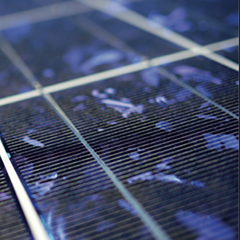Researchers at the Fraunhofer Institute for Solar Energy Systems ISE are working on a new generation of multi-junction solar cells in an industrial project with the French firm Soitec. These have the potential in the future to attain efficiency levels of over 47 per cent under concentrated sunlight. PES takes a look…
A bright summer’s day, a magnifying glass, and a sheet of paper – nothing more is needed to demonstrate the enormous energy of sunlight. With the magnifying glass, the sun’s rays can be focused on a point strongly enough to ignite the paper. The amount of solar energy concentrated
at the focal point and how it can be utilised depends in the end on the properties of the lens and of the illuminated surface.
Researchers at the Fraunhofer Institute in Freiburg have optimised both of these for effective generation of electricity. The result is a new generation of multi-junction solar cells that attain efficiencies twice as high as the best silicon cells.
The idea of concentrating light to increase the energy yield is as old as the field of photovoltaics itself. For with a good lens – which is considerably less expensive
that any semiconductor material – the solar radiation can be focused on a very small area saving money on solar cell material.
At the same time, the energy conversion efficiency climbs under concentrated light. At Fraunhofer ISE, the largest solar research Institute in Europe, a team led by the Institute’s Deputy Director, Dr. Andreas Bett, has been engaged in developing concentrated photovoltaics for a long while.
They demonstrated just how efficient this new technology can be by developing a triple-junction solar cell with an efficiency of 41.1 per cent under a concentration
of 500 suns – chalking up the new world record in 2009. Since then, this figure
has been increased repeatedly and is still headed upwards. “In contrast, silicon cells have hardly improved in the past decade. The best of them has an efficiency of around 25 per cent, already very close to the theoretically achievable limit of 29 per cent,” says Dr. Frank Dimroth, who heads III-V – Epitaxy and Solar Cells at ISE.



























